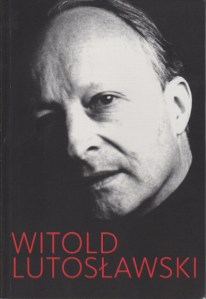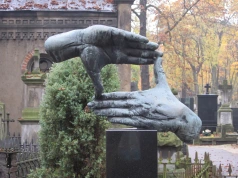• Lutosławski and his Performers (2013)
Lutosławski and his Performers
Written for Witold Lutosławski (Brussels: Institut Polonais/Pools Instituut, 2013),
as one of five brief essays published to celebrate the Lutosławski centenary.
All composers recognise their debt to the performers who bring their music to life, especially those who give the premieres. Witold Lutosławski was no exception. He wrote in 1980 that: ‘The knowledge that the new piece would be baptized by a well-known ensemble or soloists, sometimes even a great artist, was always an especially stimulating factor for me while I was composing it’. There is little evidence, however, that Lutosławski ever relied on great artists in the actual composition of his music, unlike Karol Szymanowski’s close cooperation with the violinist, Paweł Kochański. Heinz Holliger did demonstrate some oboe multiphonics, which Lutosławski then included somewhat awkwardly in the Double Concerto (1980). Mstislav Rostropovich provided the fingering for the finished solo part of the Cello Concerto (1970), but that was as far as his contribution went.
Lutosławski first wrote for renowned performers in the mid-1960s, when he was beginning to make his name outside Poland. International recognition had been held back by two circumstances beyond his control: the Second World War and the closed cultural environment of socialist realism that prevailed in Stalinist East-European countries until at least the mid-50s. After the cultural ‘thaw’, symbolised in Polish music by the first ‘Warsaw Autumn’ festival (1956), Lutosławski found his free voice more speedily and securely than most.
His big break came shortly after his fiftieth birthday, with the String Quartet (1964) written for the LaSalle Quartet. This was followed by Paroles tissées (1965) for Peter Pears, whom he had met at the ‘Warsaw Autumn’ in 1961. Over the coming years, Lutosławski was to write pieces for Rostropovich (Cello Concerto and Sacher Variation, 1975), Dietrich Fischer-Dieskau (Les Espaces du sommeil, 1975), Janet Craxton (Epitaph, 1980), Heinz and Ursula Holliger (Double Concerto), Pinchas Zukerman (Partita, 1984), Anne-Sophie Mutter (Chain 2, 1985), Krystian Zimerman (Piano Concerto, 1988) and Solveig Kringleborn (Chantefleurs et Chantefables, 1990). There were, of course, soloists whose requests went unanswered, including Lothar Faber and Ruggiero Ricci during the late 60s. Lutosławski was careful not to take on too much – he was not a fast worker – and orchestras, too, were not always successful in gaining his attention. One that was, although it had to wait some years, was the Chicago Symphony Orchestra, which premiered the Third Symphony (1983) under Sir Georg Solti.
Lutosławski relished working with his performers. He took up conducting at the premiere of Trois poèmes d’Henri Michaux at the Zagreb Biennale in 1963. Part of the reason for this was his concern that the performers should fully understand his break-through notation. This was designed to be practical as well as to fit his artistic intentions. From Jeux vénitiens (1961), his clear-cut and registrally shaped harmony was articulated by aleatory procedures, rhythmic cells which were subtly different for each performer at any one time. This meant that performers and conductor could co-ordinate loosely or as one, depending on what was required as the harmonies changed.
As a conductor, Lutosławski focused solely on his own works. His recordings (especially with the Polish Radio National Symphony Orchestra on the EMI 6-LP set of 1978, since remastered and re-released on CD) are benchmarks for their vitality, edge and conviction. He was a precise and self-contained conductor, although I do remember him once berating the percussionists during rehearsals for the Cello Concerto when, in the latter stages of the piece, he felt that they were not throwing their musical spears at the soloist with sufficient accuracy and venom.
He was very tolerant of his soloists, giving them the leeway they needed for their own interpretation. As far as he was concerned, they had just as much right to the music as he had. Very occasionally this created problems, and he preferred some interpreters to others. He hugely admired Rostropovich, but came to favour less demonstrative performances of the Cello Concerto. He apparently commented, after the premiere, that the Russian had “made the piece his own”. That could be read two ways. Certainly, Lutosławski became uncomfortable with Rostropovich’s view that this work, and his role in it, mirrored his life under oppressive Soviet authorities. And yet, in the concerto’s sketches and in private comments to Rostropovich and other interpreters of the work, including Heinrich Schiff and Roman Jabłoński, Lutosławski also wrote and talked in programmatic terms.
Lutosławski’s declared aim was always to provide a purely musical drama, whatever impulses lay hidden behind the composition. This Classical rather than Romantic outlook was what drove him creatively, even in his songs. Yet his own performances, and those by others, often brought new expressive depth to the music, and Lutosławski was composer enough to recognise that this was both inevitable and enriching.
© 2013 Adrian Thomas

